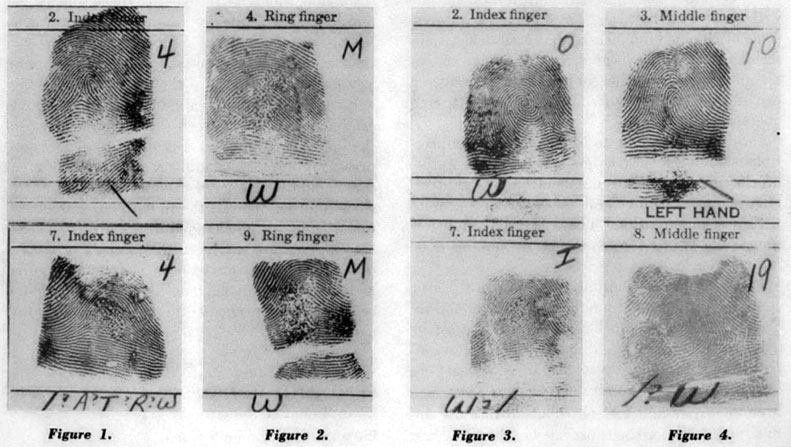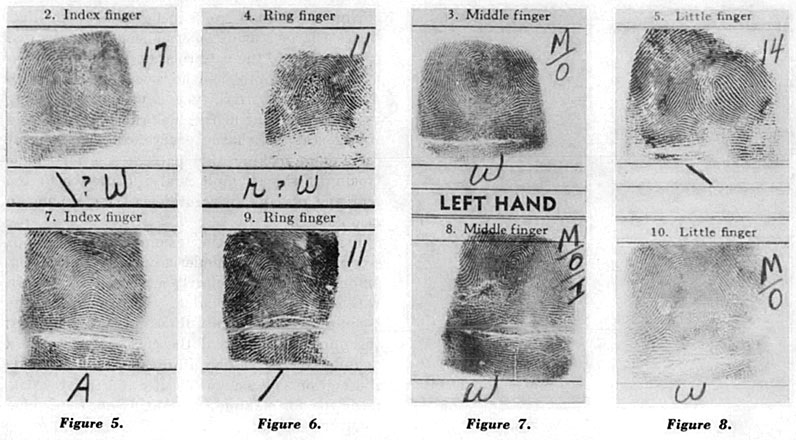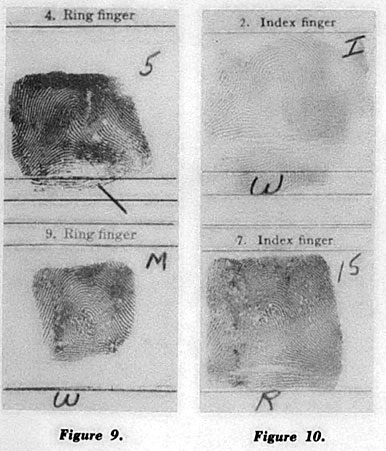Classification of the Scarred Fingerprint
FBI Law Enforcement Bulletin, April 1955
See also the instructional videos on "Fingerprint Comparison"
Since the accurate classification and searching of fingerprints require consistency and uniformity of interpretation, certain rules are observed by the Identification Division of the Federal Bureau of Investigation in the classification of scarred finger print impressions. These rules were formulated for the purpose of eliminating any possible con fusion which might result from permitting each person classifying a scarred impression to exercise individual judgment as to what the pattern might have been before it was scarred.
In the consideration of scarred impressions to be classified it should be noted that scars have been divided into two categories, i. e., "partial" and "complete," dependent upon the extent to which the pattern area has been affected by the scar. Each of these two types receives its own specific treatment in classification.
It should be noted that subclassification refer ences, although sometimes necessary, have not always been indicated in the illustrations in this article in the interest of brevity.
Complete Scars
A complete scar is one in which the pattern area has been obliterated or distorted to the extent that it is impossible to determine with any degree of accuracy the general pattern type, ridge count or tracing.
Therefore, when a fingerprint impression is so badly scarred that a reasonably accurate classification of general pattern type or subclassification is impossible, that impression is given the pattern type and subclassification of the corresponding finger of the other hand. In addition this completely scarred impression is referenced to all other pattern types that it could reasonably have been. The subclassification, i. e., ridge counts, whorl tracings, must also be referenced according to how they affeot the classification formula.
Illustrated by figure 1 is a completely scarred impression which has been given the classification of the opposite finger and referenced to all the other pattern types it could have been.

When the corresponding fingers of both hands contain complete scars, making accurate classification impossible, both patterns are given the arbitrary classification of whorls with meeting tracings as shown by figure 2.
Partial Scars
Partially scarred impressions are those in which either the general pattern type, or ridge count, or tracing can be determined with reasonable accuracy.
When an impression is only partially scarred in that it is possible to arrive at a definite ridge count or tracing, although the general pattern type cannot be determined with accuracy, that impression is given the general pattern type of the opposite finger if it could reruoruibly have been that type. However, the subclassification in this instance is taken from the ridges of the partially scarred pattern since this value can be determined with reasonable accuracy. Note that in figure 3, illustrating the above rule, the scarred impression must be referenced to any other pattern type that it might have been which is in this case an ulnar loop.
Figure 4 illustrates a partially scarred impression which could have been either a loop or a whorl type pattern. Since the pattern type cannot be definitely assigned by a study of the scarred pattern itself, the aforementioned rule has to be exercised. The pattern could have been the same type as the opposite finger; therefore, it is given that classification and referenced to the other possibility, which is a whorl type pattern. Note that the ridge count can be accurately taken from the scarred pattern.
When an impression contains a partial scar and could not have been the same general pattern type as the corresponding finger of the other hand, but is susceptible to accurate ridge counting or whorl tracing, that impression should be classified as the most probable pattern type and referenced to the remaining types that it could have been. In the interpretation of partial scars the scarred finger is never given the classification of the opposite finger arbitrarily, but only if it could reasonably have been that same general classification.

In figure 5, illustrating this rule, note that an accurate ridge count has been taken from the ridges of the partially scarred pattern. In this example the impression opposite the scarred finger is not the same general pattern type; therefore it is disregarded as a factor in the of the scarred finger.
The pattern opposite a partially scarred impression (that type in which the pattern cannot be determined with accuracy but the ridge count or tracing can be obtained) need only be of the same general pattern type to be used as a factor in the classification of the scarred finger. As an example note that in figure 6 the pattern opposite the scarred finger is an ulnar loop and that the scarred finger could never have been an ulnar loop. However, since the fingerprint impression opposite the scar is of the same geneml type, i. e., a loop type pattern, the scarred finger is given the preferential classification of a radial loop and referenced to the other pattern possihility which is a whorl.
Note that the scarred impressions in figures 3 and 6 are the same pattern but that they are classified differently. This illustrates further the influence of the corresponding finger of the other hand upon the classifying of scarred impressions.
When a partially scarred impression can be interpreted as a definite pattern type, but is not susceptible to accurate ridge counting or whorl tracing, that impression is given the ridge count or tracing of the corresponding finger of the other hand if it could reasonably have been that ridge count or tracing and if that finger is of the same general pattern type.
In figure 7 the partially scarred impression is given the pattern type as it appears. Note that in adherence to the above rule this impression is given the tracing of the opposite finger and referenced to the other possible tracing values.
However, in a partially scarred impression, wherein the pattern type is discernible but an accurate subclassification is impossible, if the corresponding finger of the hand opposite the partial scar is not the same general pattern type then the impression should be given the most probable ridge count or tracing and referenced as necessary to the classification formula.
Figure 8 is an example of a partially scarred pattern which can be classified definitely as a whorl but will not permit an accurate tracing value to be obtained. Ithas been necessary, there fore, to give this pattern the tracing that it most likely could have been before the impression be came scarred. Reference must be made to the other tracings it might possibly have been.
Many scars, although of a permanent nature and occurring within the pattern area, do not obliterate a vital portion of the fingerprint impression so as to make accurate classification impossible. This type of scar does not present a problem since the pattern is classified as it appears and none of the afore-mentioned rules be applied.

Figures 9 and 10 are examples of impressions containing scars which do not hinder accurate classification. In figure 9 note that impression No.4 contains only a fine cut scar which does not distort the pattern to any appreciable extent. The pattern can be clearly seen and interpreted as an ulnar loop with a ridge count of five. Regard less of the pattern type or subclassification of the corresponding finger of the opposite hand this pattern would be classified just as it appears.
Note impression No. 9 in figure 9 which illustrates a large scar of a permanent nature located in the center of the pattern area. Upon examination of this impression, however, we are able to determine the pattern type as well as the tracing value. Note that neither delta has been affected by the scar and that a recurve exists in front of each delta making this pattern a whorl. The tracing in this example is also unaffected by the scar and permits an accurate meeting tracing to be obtained.
Figure 10 is a further example of the type of scar which does not hinder accurate classification. Impression No.2 is clearly a whorl type pattern with an inner tracing value. The scar has cut the tracing ridges but it is still possible to trace across the unnatural break of the cut and arrive at a definite tracing value. Impression No.7 in this illustration shows a scar neither affecting the pattern type nor making a reasonably accurate ridge count impossible.

